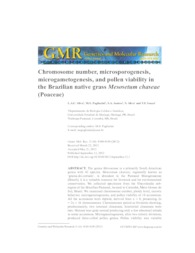Chromosome number, microsporogenesis, microgametogenesis, and pollen viability in the Brazilian native grass Mesosetum chaseae (Poaceae).
Chromosome number, microsporogenesis, microgametogenesis, and pollen viability in the Brazilian native grass Mesosetum chaseae (Poaceae).
Author(s): SILVA, L. A. C.; PAGLIARINI, M. S.; SANTOS, S. A.; SILVA, N.; SOUZA, V. F.
Summary: The genus Mesosetum is a primarily South American genus with 42 species. Mesosetum chaseae, regionally known as ?grama-do-cerrado?, is abundant in the Pantanal Matogrossense (Brazil); it is a valuable resource for livestock and for environmental conservation. We collected specimens from the Nhecolandia sub-region of the Brazilian Pantanal, located in Corumbá, Mato Grosso do Sul, Brazil. We examined chromosome number, ploidy level, meiotic behavior, microgametogenesis, and pollen viability of 10 accessions. All the accessions were diploid, derived from x = 8, presenting 2n = 2x = 16 chromosomes. Chromosomes paired as bivalents showing, predominantly, two terminal chiasmata. Interstitial chiasmata were rare. Meiosis was quite normal producing only a few abnormal tetrads in some accessions. Microgametogenesis, after two mitotic divisions, produced three-celled pollen grains. Pollen viability was variable among plant and accessions and was not correlated with meiotic abnormalities.
Publication year: 2012
Types of publication: Journal article
Unit: Embrapa Pantanal
Observation
Some of Embrapa's publications are published as ePub files. To read them, use or download one of the following free software options to your computer or mobile device. Android: Google Play Books; IOS: iBooks; Windows and Linux: Calibre.
Access other publications
Access the Agricultural Research Database (BDPA) to consult Embrapa's full library collection and records.
Visit Embrapa Bookstore to purchase books and other publications sold by Embrapa.

